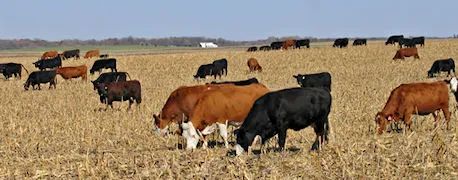Nutritional Considerations for Grazing Cornstalks
Grazing cornstalks presents a variety of challenges, the amount of ear corn on the ground due to high winds during the growing season makes this year (2017) a bit unusual, to farmers and ranchers. While there is a lot of high quality feed on the ground, many ranchers are concerned, and rightly so, about acidosis, founder, and bloat issues. This produces some significant management decisions on how to best use the feed that is available, and clean up the fields, while optimizing animal health and performance.
An important place to start is to evaluate how severe the problem is in each field. A simple formula for determining how many bushels of corn are on the ground in a particular field is to count the number of ears in 3 different 100 foot furrow strips and divide that number by 2. For example, 40 ears in your 3 rows would represent approximately 20 bushels per acre. Any amount beyond 8-10 bushels per acre will require a well-planned grazing strategy.

Once the amount of downed corn has been determined, the producer can begin making management decisions such as what class of livestock to graze, conditioning the livestock, controlling access to the corn, and nutritional supplementation. University of Nebraska at Lincoln has a number of articles that help producers with these management decisions – Estimating Bushels of Corn on the Ground and Down Corn and Down Corn – Problem or Opportunity.
While there is no supplemental product that will mitigate all of the risks of grazing corn residue with the amount of ear corn on the ground this year, Agri-Best Feeds offers a uniquely better line of products that may help producers reduce the risks of acidosis, founder, and bloat.
SweetPro is a complete supplement where minerals (copper, zinc, and manganese are 50% organically complexed) and ProBiotein (powerful digestive aid of fermented wheat, oats, barley, and flax) are delivered through a 250 pound DDGS & CDS block. All of the SweetPro blocks are complex carbohydrates (no molasses) and basic in nature (pH 9 to 10) helping to buffer the rumen. SweetPro has seen forage and intake efficiency being better for cattle on the SweetPro product which could translate into less intake and potentially help offset founder and/or acidosis. SweetPro contains a wide array of enzymes including amylase which helps break down starch. The elements (including MOS) from ProBiotein help keep the rumen stable. Finally, SweetPro’s Pasture Ranger block is a bloat block for those concerned about bloat.
Redmond Natural Trace Mineral Salt is the salt that Agri-Best Feeds recommends for all classes of livestock in all situations. Redmond Salt is a mined sea mineral that contains the natural balance of 60+ minerals in crystalloid form that is similar to blood’s mineral analysis, and is a great salt source along with providing a mineral safety net.
Redmond Conditioner is a volcanic ash that Redmond mines. Redmond Conditioner is a great rumen buffer (similar to sodium bi-carb in university trials), toxin binder, mineral supporter, and has some feed efficiency characteristics. Redmond Salt and Conditioner can be mixed for regulating intake.
Agri-Best Feeds’ recommended supplement program of SweetPro and Redmond is easy to manage, economical, and may be an option to consider for cattle grazing cornstalks. For more information on Agri-Best Feeds’ products, visit www.agribestfeeds.com or call 866 601-6646.
Click here for recorded webinar – Dealing with Excessive Downed Ears when Grazing Corn Residue – Mary Drewnoski, Beef Systems Specialist University of Nebraska-Lincoln

